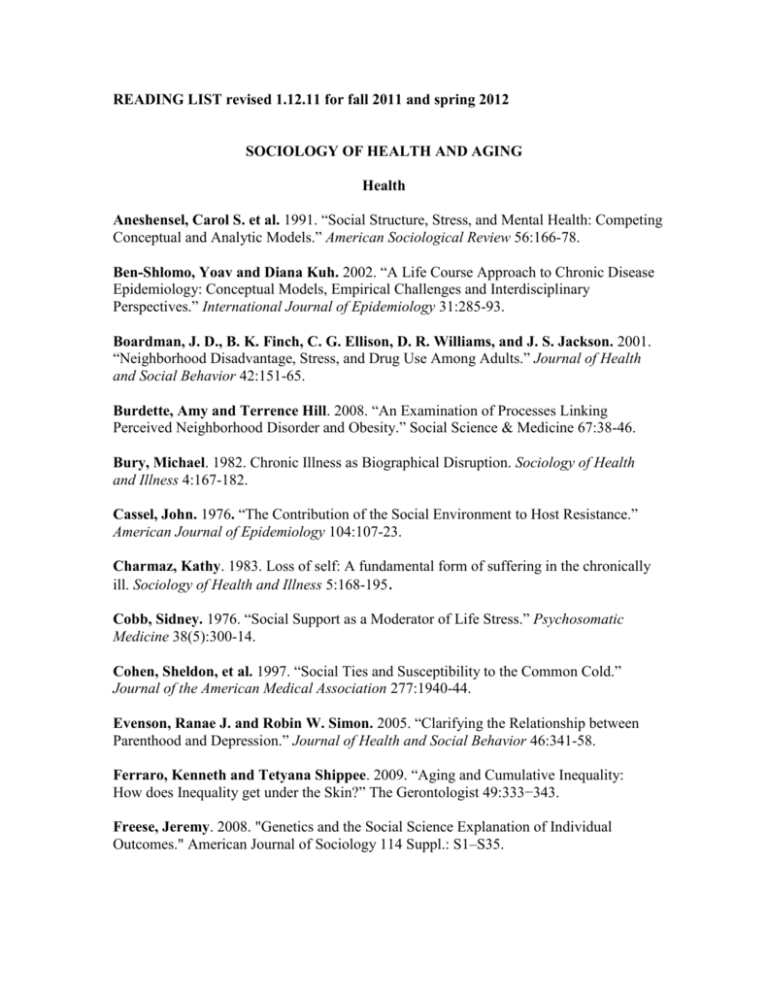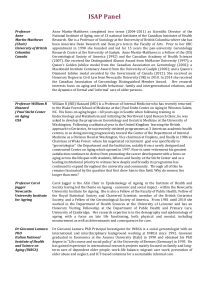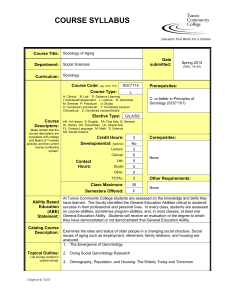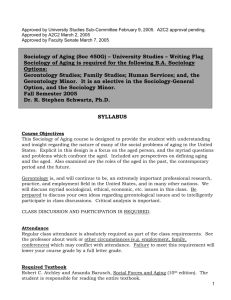Health and Aging READING LIST 1.12.11
advertisement

READING LIST revised 1.12.11 for fall 2011 and spring 2012 SOCIOLOGY OF HEALTH AND AGING Health Aneshensel, Carol S. et al. 1991. “Social Structure, Stress, and Mental Health: Competing Conceptual and Analytic Models.” American Sociological Review 56:166-78. Ben-Shlomo, Yoav and Diana Kuh. 2002. “A Life Course Approach to Chronic Disease Epidemiology: Conceptual Models, Empirical Challenges and Interdisciplinary Perspectives.” International Journal of Epidemiology 31:285-93. Boardman, J. D., B. K. Finch, C. G. Ellison, D. R. Williams, and J. S. Jackson. 2001. “Neighborhood Disadvantage, Stress, and Drug Use Among Adults.” Journal of Health and Social Behavior 42:151-65. Burdette, Amy and Terrence Hill. 2008. “An Examination of Processes Linking Perceived Neighborhood Disorder and Obesity.” Social Science & Medicine 67:38-46. Bury, Michael. 1982. Chronic Illness as Biographical Disruption. Sociology of Health and Illness 4:167-182. Cassel, John. 1976. “The Contribution of the Social Environment to Host Resistance.” American Journal of Epidemiology 104:107-23. Charmaz, Kathy. 1983. Loss of self: A fundamental form of suffering in the chronically ill. Sociology of Health and Illness 5:168-195. Cobb, Sidney. 1976. “Social Support as a Moderator of Life Stress.” Psychosomatic Medicine 38(5):300-14. Cohen, Sheldon, et al. 1997. “Social Ties and Susceptibility to the Common Cold.” Journal of the American Medical Association 277:1940-44. Evenson, Ranae J. and Robin W. Simon. 2005. “Clarifying the Relationship between Parenthood and Depression.” Journal of Health and Social Behavior 46:341-58. Ferraro, Kenneth and Tetyana Shippee. 2009. “Aging and Cumulative Inequality: How does Inequality get under the Skin?” The Gerontologist 49:333−343. Freese, Jeremy. 2008. "Genetics and the Social Science Explanation of Individual Outcomes." American Journal of Sociology 114 Suppl.: S1–S35. Hill, Terrence D., Lauren M. Kaplan, Michael T. French, and Robert J. Johnson. 2010. "Victimization in Early Life and Mental Health in Adulthood: An Examination of the Mediating and Moderating Influences of Psychosocial Resources." Journal of Health and Social Behavior 51: 48-63. House, James S. 2001. “Understanding Social Factors and Inequalities in Health: 20th Century Progress and 21st Century Prospects.” Journal of Health and Social Behavior 43:125-42. Kaplan, G., M. Haan, R. Wallace. 1999. “Understanding Changing Risk Factor Associations with Increasing Age in Adults.” Annual Review of Public Health 20:89−108. Kessler, Ronald C. 2002. “The Categorical versus Dimensional Assessment Controversy in the Sociology of Mental Illness.” Journal of Health and Social Behavior 43:171-88. Kessler, Ronald C., Kristen D. Mickelson, and David R. Williams. 1999. “The Prevalence, Distribution, and Mental Health Correlates of Perceived Discrimination in the United States.” Journal of Health and Social Behavior 40:208-30. LaVeist, Thomas A. 1996. “Why We Should Continue to Study Race But Do a Better Job: An Essay on Race, Racism and Health.” Ethnicity and Disease 6:21-29. LaVeist, Thomas A. 2005. “Disentangling Race and Socioeconomic Status: A Key to Understanding Health Inequalities.” Journal of Urban Health: Bulletin of the New York Academy of Medicine 82(2):Supplement 3. Link, Bruce and Jo Phelan. 2001. “Conceptualizing Stigma.” Annual Review of Sociology 7:363-85. Marmot, Michael, Carol D. Ryff, Larry L. Bumpass, Martin Shipley, and Nadine F. Marks. 1997. “Social Inequalities in Health: Next Questions and Converging Evidence.” Social Science and Medicine 44: 901-10. Mirowsky, John and Catherine Ross. 2003. Education, Social Status, and Health. Hawthorne, NY: Aldine de Gruyter/Transaction. Pearlin, Leonard I., Morton Lieberman, Elizabeth Menaghan, and Joseph Mullan. 1981. “The Stress Process.” Journal of Health and Social Behavior 22:337-56. Pearlin, Leonard I., Scott Schieman, Elena M. Fazio, and Stephen C. Meersman. 2005. “Stress, Health and the Life Course: Some Conceptual Perspectives.” Journal of Health and Social Behavior 46(2):205-19. Phelan, Jo C., Bruce G. Link and Parisa Tehranifar. 2010. "Social Conditions as Fundamental Causes of Health Inequalities : Theory, Evidence, and Policy Implications." Journal of Health and Social Behavior 51: S28-S40. Rabkin, Judith and Elmer Struening. 1976. “Life Events, Stress and Illness.” Science 194:1013-20. Reynolds, John R. and Chardie Baird. 2010. "Is There a Downside to Shooting for the Stars? Unrealized Educational Expectations and Symptoms of Depression." American Sociological Review 75: 151-172. Reynolds, John and R. Jay Turner. 2008. “Major Life Events, Their Personal Meaning, Resolution, and Mental Health Significance.” Journal of Health and Social Behavior 49:223-37. Rodin, Judith. 1986. “Aging and Health: Effects of the Sense of Control.” Science 233:1271−1276. Ross, C. E., J. Mirowsky, and S. Pribesh. 2001. “Powerlessness and the Amplification of Threat: Neighborhood Disadvantage, Disorder, and Mistrust.” American Sociological Review 66:568-91. Ross, C. E., J. R. Reynolds, and K. J. Geis. 2000. “The Contingent Meaning of Neighborhood Stability for Residents’ Psychological Well-Being.” American Sociological Review 65:581-97. Ross, Catherine E. and Chia-Ling Wu. 1996. “Education, Age, and the Cumulative Advantage in Health.” Journal of Health and Social Behavior 37:104-20. Simon, Robin W. 2002. “Revisiting the Relationships among Gender, Marriage, and Mental Health.” American Journal of Sociology 107:1065-96. Syme, Leonard and Lisa Berkman. 1976. “Social Class, Susceptibility and Sickness.” American Journal of Epidemiology 104:1-8. Taylor, John and R. Jay Turner. 2002. “Perceived Discrimination, Social Stress, and Depression in the Transition to Adulthood: Racial Contrasts.” Social Psychology Quarterly 65:213-25. Thoits, Peggy. 2010. “Stress and Health: Major Findings and Policy Implications Journal of Health and Social Behavior.” November 51: S41-S53. Turner, R. Jay and William R. Avison. 2003. “Status Variations in Stress Exposure: Implications for the Interpretation of Research on Race, Socioeconomic Status, and Gender.” Journal of Health and Social Behavior 44:488-505. Turner, R. Jay and Donald A. Lloyd. 1995. “Lifetime Traumas and Mental Health: The Significance of Cumulative Adversity.” Journal of Health and Social Behavior 36:36076. Turner, R. Jay and Donald A. Lloyd. 1999. “The Stress Process and the Social Distribution of Depression.” Journal of Health and Social Behavior 40:374-404. Ueno, Koji. 2010. “Mental Health Differences Between Young Adults With and Without Same-Sex Contact: A Simultaneous Examination of Underlying Mechanisms.” Journal of Health and Social Behavior (forthcoming). Umberson, Crosnoe, & Reczek. 2010 “Social Relationships and Health Behavior across the Life Course.” Annual Review of Sociology 36:139-157. Umberson, Debra et al. 1992. “Widowhood and Depression: Explaining Long-Term Gender Differences in Vulnerability.” Journal of Health and Social Behavior 33:10-24. Wheaton, Blair. 2001. “The Role of Sociology in the Study of Mental Health . . . and the Role of Mental Health in the Study of Sociology.” Journal of Health and Social Behavior 42:221-34. Wickrama, K.A.S., Rand D. Conger, and W. Todd Abraham. 2005. “Early Adversity and Later Health: The Intergenerational Transmission of Adversity through Mental Disorder and Physical Illness.” Journals of Gerontology, Series B 60B(Special Issue II):125-29. Williams, David and Sternthal. 2010. “Understanding Racial-ethnic Disparities in Health: Sociological Contributions.” Journal of Health and Social Behavior November 51: S15-S27. Aging Angel, Ronald and Jacqueline Angel. (2005). Diversity and aging in the United States. Chapter 6 in in Handbook of Aging and the Social Sciences (6th ed), edited by R. Binstock and L. George. San Diego, CA: Academic Press. Barrett, Anne E. (2003). Socioeconomic status and age identity: The role of dimensions of health in the subjective construction of age. Journals of Gerontology 58B, S101-S109. Burton, L.M. (1996). “Age Norms, the Timing of Family Role Transitions, and Intergenerational Caregiving among Aging African American Women.” The Gerontologist 2, 199-208 Calasanti, Toni and Kathleen Slevin. (2001). Gender, social inequalities and aging. Walnut creek, CA: AltaMira Press. Clark, Robert and Joseph Quinn. 2002. Patterns of work and retirement for a new century. Generations, Summer: 17-30. Cornwell, Laumann, & Schumm. 2008. “The Social Connectedness of Older Adults: A National Profile.” American Sociological Review 73:185-203. Diamond, Timothy. (1995). Making Gray Gold: Narratives of Nursing Home Care. Chicago, IL: University of Chicago Press. Elwert, Felix and Nicholas Christakis. (2006). Widowhood and Race. American Sociological Review 71: 16-41. Ferraro, Kenneth. (2001) Aging and role transitions. Pp. 313-330 in Binstock and George (eds.) Handbook of Aging and the Social Sciences, 5th ed. San Diego, CA: Academic Press. Foster, Holly, John Hagan, and Jeanne Brooks-Gunn. 2008. "Growing Up Fast: Stress Exposure and Subjective 'Weathering' in Emerging Adulthood." Journal of Health and Social Behavior 49: 162-177. George, Linda K. (1999) Social perspectives on the self in later life. Pp. 42-66 in Ryff and Marshall, The self and society in aging processes. Springer Publishing. George, Linda. 2010. Still happy after all these years: Research frontiers on subjective well-being in later life. Journals of Gerontology: Series B: Psychological Sciences and Social Sciences. 65B: 331-339. George, Linda. (2001). The Social Psychology of Health. Pp. 217-35 in Handbook of Aging and the Social Sciences, 5th ed., edited by R. Binstock and L. George. San Diego, CA: Academic Press. Geronimus, Arline T. 2001. "Understanding and Eliminating Racial Inequalities in Women's Health in the United States: The Role of the Weathering Conceptual Framework." Journal of the American Medical Women's Association 56(4): 133-136. Geronimus, Arline T., Margaret Hicken, Danya Keene, and John Bound. 2006. "'Weathering' and Age-Patterns of Allostatic Load Scores among Blacks and Whites in the United States." American Journal of Public Health 96: 826-833. Hagestad, Gunhild (2002) Interdependent lives and relationships in changing times: A life-course view of families and aging, Pp. 135-159 in Invitation to the life course, edited by R. Settersten. Baywood Publishing. Holstein, Martha B. and Meredith Minkler. (2003). Self, society, and the “new gerontology.” The Gerontologist 43: 787-796. Hao, Yanni. 2008. “Productive Activities and Psychological Well-Being among Older Adults.” Journal of Gerontology 63B (2):S64-72. Kelley-Moore, Jessica, John G. Schumacher, Eva Kahana, and Boaz Kahana. (2006). When do older adults become “disabled”? Social and health antecedents of perceived disability in a panel study of the oldest old. Journal of Health and Social Behavior 47: 126-141. Krause, Neal (2005). Social relationships in late life. Pp. 182-201 in Handbook of Aging and the Social Sciences (6th ed.) edited by R. Binstock and L. George. San Diego, CA: Academic Press. Mayer, Karl U. 2009. “New Directions in Life Course Research”. Annual Review of Sociology 35: 413-433. Mirowsky, J (1996). Age and the Gender Gap in Depression. Journal of Health and Social Behavior 37 362-80. Moen, Phyllis and Donna Spencer. (2005). Converging divergences in age, gender, health, and well-being: Strategic selection in the third age. Pp. 129-145 in Handbook of Aging and the Social Sciences (6th ed.), edited by R. Binstock and L. George. San Diego, CA: Academic Press. Moen, Phyllis, Julie Robison, and Donna Dempster-McLain. 1995. “Caregiving and Women’s Well-Being: A Life Course Approach.” Journal of Health and Social Behavior 36:259-73. McMullin, Julie and Victor Marshall. 2001. “Ageism, age relations, and garment industry work in Montreal.” The Gerontologist. 41:111-122. Moen, Phyllis. (2001). The gendered life course. Pp. 179-196 in Binstock, George and associates (eds.) Handbook of aging and the social sciences (5th ed). San Diego, CA: Academic Press. Mutchler, Jan, Jeffrey Burr, Michale Massagli, and Amy Pienta. 1999. Work transitions and health in later life. Journals of Gerontology 54B: S252-61. O’Rand, Angela. 1996. “The Precious and Precocious: Understanding Cumulative Disadvantage and Cumulative Advantage Over the Life Course.” The Gerontologist 36:230-38. O’Rand, Angela. (2005) Stratification and the life course: Life course capital, life course risks, and social inequality. Pp. 146-201 in Handbook of Aging and the Social Sciences (6th ed.), edited by R. Binstock and L. George. San Diego, CA: Academic Press. Pearlin, L.I., Pioli, M and McLaughlin, A. (2001). Caregiving by adult children: Involvement, role disruption and health. Pp. 238-53 in Handbook of Aging and the Social Sciences, 5th ed., edited by R. Binstock and L. George. San Diego, CA: Academic Press. Pollner, M. and Rosenfeld, D. 2000. “The cross-culturing work of gay and lesbian elderly.” Advances in Life Course Research 5: 99-117. Rosenfeld, Dana. 1999. "Identity Work among Lesbian and Gay Elderly." Journal of Aging Studies 13(2):121-144. Settersten, Jr., RA. (2005). Linking the two ends of life: What gerontology can learn from childhood studies. Journals of Gerontology: Social Sciences, 60B(4), S173-180. Settersten, Richard A. and Karl Ulrich Mayer. (1997). The measurement of age, age structuring, and the life course. Annual Review of Sociology 23: 233-261. Stone, Robyn (2005). Emerging issues in long-term care. Chapter 22 in in Handbook of Aging and the Social Sciences (6th), edited by R. Binstock and L. George. San Diego, CA: Academic Press. Street, Debra, Stephanie Burge, Jill Quadagno, and Anne Barrett. 2007. “The Salience of Social Relationships on Resident Wellbeing in Assisted Living.” Journal of Gerontology 62B (2):S129-134. Tiefer, Leonore. 2006. "The Viagra Phenomenon." Sexualities 9:273-294. Uhlenberg, Peter. 2009. “Children in an aging society.” Journal of Gerontology: Social Sciences, 64B: 489–496. Umberson, Debra, Kristi Williams, Daniel A. Powers, Meichu D. Chen, and Anna M. Campbell. 2005. “As Good as it Gets? A Life Course Perspective on Marital Quality.” Social Forces 84: 493-511. Willson, Andrea E., Kim M. Shuey, and Glen H. Elder, Jr. 2007. “Cumulative Advantage Processes as Mechanisms of Inequality in Life Course Health.” American Journal of Sociology 112: 1811-1847. Willson, Andrea and Melissa Hardy. 2002. “Racial disparities in income security for a cohort of aging American women.” Social Forces 80 (4):1283-1306. Winterich, Julie A. 2003. "Sex, Menopause, and Culture: Sexual Orientation and the Meaning of Menopause for Women's Sex Lives." Gender and Society 17:627-642. Methods Beckett, Megan. 2000. “Converging Health Inequalities in Later Life-An Artifact of Mortality Selection?” Journal of Health and Social Behavior 41: 106-119. Blossfeld, Hans-Peter. 2009. “Comparative Life Course Research: A Cross-National and Longitudinal Perspective”. Chap. 13 in The Craft of Life Course Research, Glen H. Elder Jr. and Janet Z. Giele, Eds. The Guilford Press. Bowling, Ann. 2005. Measuring Health: A Review of Quality of Life Measurement Scales, 3rd Edition. Maidenhead, Berkshire: Open University Press. Burton, Linda M., Diane Purvin and Raymond Garrett-Peters. 2009. “Longitudinal Ethnography: Uncovering Domestic Abuse in Low-Income Women’s Lives”. Chap. 4 in The Craft of Life Course Research, Glen H. Elder Jr. and Janet Z. Giele, Eds. The Guilford Press. Campbell, Richard and Duane Alwin. (1996). Quantitative approaches: Toward and integrated science of aging and human development. Pp. 31-51 in Handbook of aging and the social sciences (4th ed). Edited by Binstock and George. San Diego, CA: Academic Press. Cohler, Bertram J. and Andrew Hostetler (2003). “Linking Life Course and Life Story: Social Change and the Narrative Study of Lives Over Time.” Pp. 555-576 in Handbook of the Life Course by Mortimer and Shanahan. Crimmins, Eileen and Teresa Seeman. 2001. “Integrating Biology into Demographic Research on Health and Aging.” Pp. 9-41 in Cells and Surveys: Should Biological Measures be Included in Social Science Research?, edited by C. Finch, J. Vaupel, and K. Kinsella. Washington, D.C.: National Academy Press. Diez Roux, Ana V. 2001. “Investigating Neighborhood and Area Effects on Health” American Journal of Public Health 91: 1783-89. Dohrenwend, Bruce P. 1990. “The Problem of Validity in Field Studies of Psychological Disorders’ Revisited.” In Lee Robbins and James Barrett (eds.), The Validity of Psychiatric Diagnosis. Psychological Medicine 20:195-208. Dohrenwend, Bruce P. et al. 1992. “Socioeconomic Status and Psychiatric Disorders: The Causation-Selection Issue.” Science 255:946-52. Ekerdt, (2010). “Frontiers of Research on Work and Retirement” Journals of Gerontology Series B: Psychological Sciences and Social Sciences 65B:69-80. Freese, Jeremy. 2008. "Genetics and the Social Science Explanation of Individual Outcomes." American Journal of Sociology 114: S1-S35. George, Linda K. 2009. “Conceptualizing and Measuring Trajectories.” Chap. 8 in The Craft of Life Course Research, Glen H. Elder Jr. and Janet Z. Giele, Eds. The Guilford Press. Glen, Norval D. (2003) Distinguishing Age, Period, and Cohort Effects, Pp. 465-476 in Jeylan Mortimer and Michael Shanahan (eds.) Handbook of the Life Course. NY: Kluwer Academic/Plenum Publishers. Giele, Janet Z. 2009. “Life Stories to Understand Diversity: Variations by Class, Race, and Gender” Chap. 11 in The Craft of Life Course Research, Glen H. Elder Jr. and Janet Z. Giele, Eds. The Guilford Press. Hauser, Robert M. and Robert J. Willis. 2004. “Survey Design and Methodology in the Health and Retirement Study and the Wisconsin Longitudinal Study.” Population Development and Review 30: 209-244. Hendricks, Jon (1996). Qualitative research: Contributions and Advances. Pp. 52-72 in Handbook of Aging and the Social Sciences (4th ed.). Editied by Binstock and George,. San Diego, CA. Horwitz, Allan V., Helene Raskin White, and Sandra Howell-White. 2002. “The Use of Multiple Outcomes in Stress Research.” Journal of Health and Social Behavior 37:278-91. Mayer, Karl U. and Nancy Tuma. (1990). Life course research and event history analysis: An overview. Pp. 3-20 in Event History Analysis in Life Course Research, edited by K.U. Mayer and N.B. Tuma. Madison, WI: University of Wisconsin Press. Mirowsky, J. and C.E. Ross. 1989. “Psychiatric Diagnosis as Reified Measurement” (with invited responses). Journal of Health and Social Behavior 30:11-40. Mirowsky, John and Catherine Ross. 2003. Social Causes of Psychological Distress. Hawthorne, NY: Aldine de Gruyter/Transaction. Noymer, Andrew. 2001. “Mortality Selection and Sample Selection: A Comment on Beckett.” and “Reply to Noymer” Journal of Health and Social Behavior 42: 326-327 & 328-331. Phelan, Jo C. and Bruce Link. Unpublished. “The Illusion of Simple Truths.” Shanahan, Michael J., and Scott M. Hofer. 2005. “Social Context in Gene-Environment Interactions: Retrospect and Prospect.” Journals of Gerontology 60B: 65–76. Taylor, Miles G. 2008. "Timing, Accumulation, and the Black/White Disability Gap in Later Life: A Test of Weathering." Research on Aging: Special Issue on Race, SES, and Health 30: 226-250.





